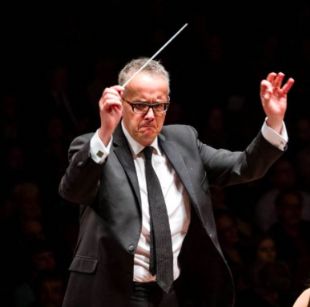|
Symphony
FROM THE NEW WORLD TO THE OLD WORLD
by Peter Lert
Saturday, June 14, 2025
Chamber
MC2 DUO RECITAL CLOSES 222'S SEASON
by Terry McNeill
Saturday, June 14, 2025
Choral and Vocal
CANTIAMO SONOMA'S LUSCIOUS A CAPELLA SINGING IN SEASON ENDING CONCERT
by Pamela Hicks Gailey
Sunday, June 8, 2025
Symphony
SRS SEASON ENDS WITH RESOUNDING TA-TA-TA-BANG
by Terry McNeill
Sunday, June 1, 2025
Symphony
YOUTHFUL VIRTUOSITY ON DISPLAY AT USO'S MAY CONCERTS
by Peter Lert
Saturday, May 17, 2025
Symphony
MYSTICAL PLANETS AND LIVELY GERSHWIN ORTIZ AT FINAL SRS CONCERT
by Peter Lert
Sunday, May 4, 2025
Symphony
VSO'S CONCERT MUSIC OF TIME, MUSIC OF PLACE
by Peter Lert
Sunday, April 27, 2025
VOCAL ELEGANCE AND FIRE AT THE 222'S RECITAL APRIL 26
by Pamela Hicks Gailey
Saturday, April 26, 2025
CANTIAMO SONOMA SINGS AN INSPIRED GOOD FRIDAY MOZART REQUIEM CONCERT
by Pamela Hicks Gailey
Friday, April 18, 2025
DRAMATIC SHOSTAKOVICH SYMPHONY CLOSES PHILHARMONIC'S 25TH SEASON
by Terry McNeill
Sunday, April 13, 2025
|
 |
 Conductor Marc Taddei |
DVORAK SYMPHONY CYCLE CONTINUES IN VSO SEASON OPENING CONCERT
by Terry McNeill
Sunday, November 3, 2019
There was a surprise at the Nov. 3 Vallejo Symphony’s 88th season opening Concert. Of the three works programed by conductor Marc Taddei, the Bartok E major Piano Concerto was the least craggy and sonically demanding. Bartok upstaged in musical impact? How so?
Before a nearly sold out Empress Theater audience Mr. Taddei omitted the usual season-opening Star Spangled Banner and after brief remarks regarding the year’s themes (“Great and Noble” and completing a cycle of Dvorák Symphonies) directed an energetic performance of Barber’s First Symphony, Op. 9. Lasting just 21 minutes, the 1936 work had splendid cello-clarinet duos, potent tympani playing from John Weeks, and the golden sound from the middle of the Orchestra from oboist Curtis Kidwell.
Mr. Taddei’s conducting style is all business with distinct cues, certainly needed in the music that swirled from neo-romantic lyricism to sonorous flowing climaxes that at times encompassed a hint of remorse. The conductor’s section control in the Passacaglia (near the end) was sure and generated a big sound in the Empress’ non-reverberant space. This Symphony is often compared with the Sibelius Seventh, but to me they are far apart, and the Sibelius (played last season by the VSO) ends quietly in a mysterious ascending phrase. Here the conductor shaped a big sound, and in the applause he singled out Mr. Kidwell.
The hall’s piano (not a Steinway) was set center stage with soloist Bobby Mitchell tackling the third Bartok Concerto, an autumnal for Bartok work that sharply diverges from the two dissonant and difficult predecessors. Using a score but only sporadically looking at it, Mr. Mitchell adopted clipped phrases and a dry tone that suited the instrument and the music composed in 1945 at the end of Bartok’s life. There was sharply etched thematic projection throughout the three-movement work. Mr. Taddei was in no hurry with tempos and shaped the long lines and chordal weighting in the Adagio Religioso with care. Laurie Siebold’s piccolo playing was adroit.
In the Allegro Vivace finale balancing instrumental sections is paramount, and Mr. Taddei met the challenge admirably, controlling the often explosive outbursts. Mr. Mitchell’s playing kept pace and even a delightful piano ascending Glissando was added to the mix. A sterling performance of a masterpiece.
Following intermission Dvorák’s D Minor Symphony (No. 7) was heard, one of the last of the Dvorák Symphonies Mr. Taddei has led over several seasons since joining the VSO in 2016. Brahms was an admirer and mentor to Dvorák, and the German master’s C Minor Symphony is mentioned as a model to the Czech composer’s No. 7. Again for me the comparison is weak, and much more Bruckner and different textures seem imbued in the work that premiered in 1885. Mr. Taddei drew a resolute and authoritative reading from his Orchestra, though powerful brass playing frequently overpowered the high strings and made quick ascending unison playing in the first violins blurred.
Throughout the four movements flutist Melanie Keller played the virtuoso parts with consummate artistry, often in duos with clarinetist Diane Maltester and in conjunction with the horn section. The Poco Adagio opened like a summer flower with soft string sound and bucolic woodwind playing. In the Scherzo Mr. Taddei focused on the Czech character of the music with exemplary playing in duos from the cello section and bassoonists Jarratt Rossini and Michelle Keem.
Mr. Taddei continued his consummate orchestral authority in the finale, especially in a dark hued chorale section. In 38 minutes that seemed short the Dvorak’s 7th was an organic whole, the VSO playing splendidly and affirming the conductor’s clear connection with a masterful Symphony and glorious composer.
Audience reaction was swift and loud with applause, the only possible response. Additional Dvorák Symphonies are scheduled for the sets Feb. 29/March 1 and April 18/19, both in the Empress.
|

